Influence of the Thickness of a Nanolayer Composite Coating on Values of Residual Stress and the Nature of Coating Wear
Abstract
1. Introduction
2. Materials and Methods
3. Results
3.1. Influence of the Coating Thickness on the Values and Nature of Residual Stress
3.2. Influence of Compressive Residual Stress and Internal Defects in Coatings of Large Thicknesses on the Formation of Interlayer Delamination
4. Discussion
5. Conclusions
Author Contributions
Funding
Conflicts of Interest
References
- Abadias, G.; Chason, E.; Keckes, J.; Sebastiani, M.; Thompson, G.B.; Barthel, E.; Doll, G.L.; Murray, C.E.; Stoessel, C.H.; Martinu, L. Review Article: Stress in thin films and coatings: Current status, challenges, and prospects. J. Vac. Sci. Technol. A 2018, 36, 020801. [Google Scholar] [CrossRef]
- Soroka, O.B. Evaluation of residual stresses in PVD-coatings. Part 1. Review. Strength Mater. 2010, 42, 287–296. [Google Scholar] [CrossRef]
- Soroka, O.B.; Klymenko, S.A.; Kopeikina, M.Y. Evaluation of residual stresses in PVD-coatings. Part 2. Strength Mater. 2010, 42, 450–458. [Google Scholar] [CrossRef]
- Koch, R. Stress in Evaporated and Sputtered Thin Films—A Comparison. Surf. Coat. Technol. 2010, 204, 1973–1982. [Google Scholar] [CrossRef]
- George, M.; Coupeau, C.; Colin, J.; Grilhe, J. Mechanical behaviour of metallic thin films on polymeric substrates and the effect of ion beam assistance on crack propagation. Acta Mater. 2005, 53, 411–417. [Google Scholar] [CrossRef]
- Marx, V.M.; Toth, F.; Wiesinger, A.; Berger, J.; Kirchlechner, C.; Cordill, M.J.; Fischer, F.D.; Rammerstorfer, F.G.; Dehm, G. The influence of a brittle Cr interlayer on the deformation behavior of thin Cu films on flexible substrates: Experiment and mode. Acta Mater. 2015, 89, 278–289. [Google Scholar] [CrossRef]
- Coupeau, C. Atomic force microscopy study of the morphological shape of thin film buckling. Thin Solid Films 2002, 406, 190–194. [Google Scholar] [CrossRef]
- Moon, M.W.; Chung, J.W.; Lee, K.R.; Oh, K.H.; Wang, R.; Evans, A.G. An experimental study of the influence of imperfections on the buckling of compressed thin films. Acta Mater. 2002, 50, 1219–1227. [Google Scholar] [CrossRef]
- Bemporad, E.; Sebastiani, M.; Casadei, F.; Carassiti, F. Modelling, production and characterisation of duplex coatings (HVOF and PVD) on Ti-6Al-4V substrate for specific mechanical applications. Surf. Coat. Technol. 2007, 201, 7652–7662. [Google Scholar] [CrossRef]
- Schmidt, S.; Hanninen, T.; Wissting, J.; Hultman, L.; Goebbels, N.; Santana, A.; Tobler, M.; Hogberg, H. SiNx coatings deposited by reactive high power impulse magnetron sputtering: Process parameters influencing the residual coating stress. J. Appl. Phys. 2017, 121, 171904. [Google Scholar] [CrossRef]
- Chang, J.Y.; Yu, G.P.; Huang, J.H. Determination of Young’s modulus and Poisson’s ratio of thin films by combining 2 sin ψ X-ray diffraction and laser curvature methods. Thin Solid Films 2009, 517, 6759–6766. [Google Scholar] [CrossRef]
- Volmer, M.; Weber, A. Crystallization of Curcumin and Cinnamic Acid from Aqueous Solutions of Hydrotropes. Z. Phys. Chem. 1926, 119, 277–301. [Google Scholar]
- Frank, F.C.; van der Merwe, J.H. One-dimensional dislocations. I. Static theory. Proc. R. Soc. A 1949, 198, 205–216. [Google Scholar]
- Stranski, I.N.; Krastanow, L. Zur theorie der orientierten ausscheidung von ionenkristallen aufeinander. Mon. Chem. 1937, 71, 351–364. [Google Scholar] [CrossRef]
- Grigoriev, S.N.; Metel, A.S.; Fedorov, S.V. Modification of the structure and properties of high-speed steel by combined vacuum-plasma treatment. Met. Sci. Heat Treat. 2012, 54, 8–12. [Google Scholar] [CrossRef]
- Sobol, O.V.; Andreev, A.A.; Grigoriev, S.N.; Volosova, M.A.; Gorban, V.F. Vacuum-arc multilayer nanostructured TiN/Ti coatings: Structure, stress state, properties. Met. Sci. Heat Treat. 2012, 54, 28–33. [Google Scholar] [CrossRef]
- Metel, A.; Grigoriev, S.; Melnik, Y.; Panin, V.; Prudnikov, V. Cutting Tools Nitriding in Plasma Produced by a Fast Neutral Molecule Beam. Jpn. J. Appl. Phys. 2011, 50, 08JG04. [Google Scholar] [CrossRef]
- Grigoriev, S.N.; Melnik, Y.A.; Metel, A.S.; Panin, V.V. A Compact Vapor Source of Conductive Target Material Sputtered by 3-keV Ions at 0.05-Pa Pressure. Instrum. Exp. Tech. 2009, 52, 731–737. [Google Scholar] [CrossRef]
- Fominski, V.Y.; Grigoriev, S.N.; Celis, J.P.; Romanov, R.I.; Oshurko, V.B. Structure and mechanical properties of W-Se-C/diamond-like carbon and W-Se/diamond-like carbon bi-layer coatings prepared by pulsed laser deposition. Thin Solid Films 2012, 520, 6476–6483. [Google Scholar] [CrossRef]
- Vereschaka, A.S.; Grigoriev, S.N.; Tabakov, V.P.; Sotova, E.S.; Vereschaka, A.A.; Kulikov, M.Y. Improving the efficiency of the cutting tool made of ceramic when machining hardened steel by applying nano-dispersed multi-layered coatings. Key Eng. Mater. 2014, 581, 68–73. [Google Scholar] [CrossRef]
- Vereschaka, A.A.; Vereschaka, A.S.; Grigoriev, S.N.; Kirillov, A.K.; Khaustova, O.U. Development and research of environmentally friendly dry technological machining system with compensation of physical function of cutting fluids. Procedia CIRP 2013, 7, 311–316. [Google Scholar] [CrossRef]
- Chaudhari, P. Grain growth and stress relief in thin films. J. Vac. Sci. Technol. 1972, 9, 520–522. [Google Scholar] [CrossRef]
- Koch, R.; Abermann, R. Microstructural changes in vapour-deposited silver, copper and gold films investigated by internal stress measurements. Thin Solid Films 1986, 140, 217–226. [Google Scholar] [CrossRef]
- Djaziri, S.; Renault, P.-O.; Le Bourhis, E.; Goudeau, P.; Faurie, D.; Geandier, G.; Mocuta, C.; Thiaudière, D. Comparative study of the mechanical properties of nanostructured thin films on stretchable substrates. J. Appl. Phys. 2014, 116, 093504. [Google Scholar] [CrossRef]
- Singh, D.R.P.; Deng, X.; Chawla, N.; Hubbard, C.; Tang, G.; Shen, Y.-L. Residual stress characterization of Al/SiCnanoscale multilayers using X-ray synchrotron radiation. Thin Solid Films 2010, 519, 759–765. [Google Scholar] [CrossRef]
- Chason, E. A kinetic analysis of residual stress evolution in polycrystalline thin films. Thin Solid Films 2012, 526, 1–14. [Google Scholar] [CrossRef]
- Bielawski, M. Residual stress control in TiN/Si coatings deposited by unbalanced magnetron sputtering. Surf. Coat. Technol. 2006, 200, 3987–3995. [Google Scholar] [CrossRef]
- Li, Q.; Gou, Y.; Wang, T.G.; Gu, T.; Yu, Q.; Wang, L. Study on Local Residual Stress in a Nanocrystalline Cr O Coating byMicro-Raman Spectroscopy. Coatings 2019, 9, 500. [Google Scholar] [CrossRef]
- Koch, R.; Hu, D.; Das, A.K. Compressive stress in polycrystalline Volmer-Weber films. Phys. Rev. Lett. 2005, 94, 146101. [Google Scholar] [CrossRef]
- Engwall, A.M.; Rao, Z.; Chason, E. Origins of residual stress in thin films: Interaction between microstructure and growth kinetics. Mater. Des. 2016, 110, 616–623. [Google Scholar] [CrossRef]
- Veprek, S.; Karvankova, P.; Prochazka, J.; Männling, H. Different mechanisms leading to superhard coatings: Stable nanocomposites and high biaxial compressive stress. Mater. Res. Soc. Symp. Proc. 2002, 697, 27–32. [Google Scholar] [CrossRef]
- Hwang, Y.; Ahn, H.; Kang, M.; Um, Y. The effects of thermally-induced biaxial stress on the structural, electrical, and optical properties of Cu2O thin films. Curr. Appl. Phys. 2015, 15, S89–S94. [Google Scholar] [CrossRef]
- Tien, C.-L. Biaxial stresses, surface roughness and microstructure in evaporated TiO2 films with different deposition geometries. Appl. Surf. Sci. 2009, 256, 870–875. [Google Scholar] [CrossRef]
- Vereschaka, A.A.; Grigoriev, S.N.; Sitnikov, N.N.; Oganyan, G.V.; Batako, A. Working efficiency of cutting tools with multilayer nano-structured Ti–TiCN–(Ti,Al)CN and Ti–TiCN–(Ti,Al,Cr)CN coatings: Analysis of cutting properties, wear mechanism and diffusion processes. Surf. Coat. Technol. 2017, 332, 198–213. [Google Scholar] [CrossRef]
- Vereschaka, A.; Aksenenko, A.; Sitnikov, N.; Migranov, M.; Shevchenko, S.; Sotova, C.; Batako, A.; Andreev, N. Effect of adhesion and tribological properties of modified composite nano-structured multi-layer nitride coatings on WC–Co tools life. Tribol. Int. 2018, 128, 313–327. [Google Scholar] [CrossRef]
- Vereschaka, A.; Tabakov, V.; Grigoriev, S.; Sitnikov, N.; Milovich, F.; Andreev, N.; Bublikov, J. Investigation of wear mechanisms for the rake face of a cutting tool with a multilayer composite nanostructured Cr–CrN–(Ti,Cr,Al,Si)N coating in high-speed steel turning. Wear 2019, 438–439, 203069. [Google Scholar] [CrossRef]
- Vereschaka, A.; Grigoriev, S.; Sitnikov, N.; Aksenenko, A.; Milovich, F.; Andreev, N.; Oganyan, G.; Bublikov, Y. Influence of the Thickness of Multilayer Composite Nano-Structured Coating Ti–TiN–(Ti,Al,Si)N on the Tool Life of Metal-Cutting Tools and the Nature of Wear. Coatings 2019, 9, 730. [Google Scholar] [CrossRef]
- Hauk, V. Structural and Residual Stress Analysis by Nondestructive Methods; Elsevier, B.V.: Amsterdam, The Netherlands, 1997. [Google Scholar]
- Birkholz, M.; Genzel, C. Thin Film Analysis by X-ray Scattering; Birkholz, M., Ed.; Wiley-VCH Verlag GmbH: Weinheim, Germany, 2006; pp. 239–296. [Google Scholar]
- Keckes, J. Simultaneous determination of experimental elastic and thermal strains in thin films. J. Appl. Crystallogr. 2005, 38, 311–318. [Google Scholar] [CrossRef]
- Betsofen, S.Y.; Plikhunov, V.A.; Ashmarin, A.A. X-ray technique for the estimation of residual stresses after shot-blasting metal forming. Russ. Metall. 2008, 2008, 148–154. [Google Scholar] [CrossRef]
- Metel, A.S.; Grigoriev, S.N.; Melnik, Y.A.; Bolbukov, V.P. Broad beam sources of fast molecules with segmented cold cathodes and emissive grids. Instrum. Exp. Tech. 2012, 55, 122–130. [Google Scholar] [CrossRef]
- Vereschaka, A.A.; Grigoriev, S.N.; Sitnikov, N.N.; Batako, A. Delamination and longitudinal cracking in multi-layered composite nano-structured coatings and their influence on cutting tool life. Wear 2017, 390–391, 209–219. [Google Scholar] [CrossRef]
- Vereschaka, A.; Tabakov, V.; Grigoriev, S.; Aksenenko, A.; Sitnikov, N.; Oganyan, G.; Seleznev, A.; Shevchenko, S. Effect of adhesion and the wear-resistant layer thickness ratio on mechanical and performance properties of ZrN–(Zr,Al,Si)N coatings. Surf. Coat. Technol. 2019, 357, 218–234. [Google Scholar] [CrossRef]
- Metel, A.S.; Grigoriev, S.N.; Melnik, Y.A.; Prudnikov, V.V. Glow discharge with electrostatic confinement of electrons in a chamber bombarded by fast electrons. Plasma Phys. Rep. 2011, 37, 628–637. [Google Scholar] [CrossRef]
- Vereschaka, A.; Tabakov, V.; Grigoriev, S.; Sitnikov, N.; Oganyan, G.; Andreev, N.; Milovich, F. Investigation of wear dynamics for cutting tools with multilayer composite nanostructured coatings in turning constructional steel. Wear 2019, 420–421, 17–37. [Google Scholar] [CrossRef]
- Oliver, W.C.; Pharr, G.M.J. An improved technique for determining hardness and elastic modulus using load and displacement sensing indentation. J. Mater. Res. 1992, 7, 1564–1583. [Google Scholar] [CrossRef]
- Clemens, B.M.; Bain, J.A. Stress Determination in Textured Thin Films Using X-ray Diffraction. MRS Bull. 1992, 17, 46–51. [Google Scholar] [CrossRef]
- Kim, Y.-W.; Moser, J.; Petrov, I.; Greene, J.E.; Rossnagel, S.M. Directed sputter deposition of AlCu: Film microstructure and microchemistry. J. Vac. Sci. Technol. A 1994, 12, 3169–3175. [Google Scholar] [CrossRef]
- Wang, H.; Webb, T.; Bitler, J.W. Study of thermal expansion and thermal conductivity of cemented WC-Co composite. Int. J. Refract. Met. Hard Mater. 2015, 49, 170–177. [Google Scholar] [CrossRef]
- Saringer, C.; Kickinger, C.; Munnik, F.; Mittererc, C.; Schalk, N.; Tkadletz, M. Thermal expansion of magnetron sputtered TiCxN1−x coatings studied by high-temperature X-ray diffraction. Thin Solid Films 2019, 688, 137307. [Google Scholar] [CrossRef]
- Bartosik, M.; Holec, D.; Apel, D.; Klaus, M.; Genzel, C.; Keckes, J.; Arndt, M.; Polcik, P.; Koller, C.M.; Mayrhofer, P.H. Thermal expansion of Ti-Al-N and Cr-Al-N coatings. Scr. Mater. 2017, 127, 182–185. [Google Scholar] [CrossRef]
- Chason, E.; Sheldon, B.W.; Freund, L.B.; Floro, J.A.; Hearne, S. Origin of compressive residual stress in polycrystalline thin films. J. Phys. Rev. Lett. 2002, 88, 1561031–1561034. [Google Scholar] [CrossRef] [PubMed]
- Fominski, V.Y.; Grigoriev, S.N.; Gnedovets, A.G.; Romanov, R.I. Pulsed laser deposition of composite Mo-Se-Ni-C coatings using standard and shadow mask configuration. Surf. Coat. Technol. 2012, 206, 5046–5054. [Google Scholar] [CrossRef]
- Grigoriev, S.N.; Melnik, Y.A.; Metel, A.S.; Panin, V.V.; Prudnikov, V.V. Broad beam source of fast atoms produced as a result of charge exchange collisions of ions accelerated between two plasmas. Instrum. Exp. Tech. 2009, 52, 731–737. [Google Scholar] [CrossRef]
- d’Heurle, F.M. Aluminum films deposited by rf sputtering. Metall. Trans. 1970, 1, 725–732. [Google Scholar] [CrossRef]
- Pletea, M.; Koch, R.; Wendrock, H.; Kaltofen, R.; Schmidt, O.G. In situ stress evolution during and after sputter deposition of Al thin films. J. Phys. Condens. Matter 2009, 21, 225008. [Google Scholar] [CrossRef]
- Ravi, S.; Praveena, A.S. On von Mises type conditions for p-max stable laws, rates of convergence and generalized log Pareto distributions. J. Stat. Plan. Inference 2011, 141, 3021–3034. [Google Scholar] [CrossRef]
- Sharipov, O.S. Invariance principle for U-statistics and von mises’ functionals of weakly dependent observations. Theory Probab. Appl. 2003, 47, 730–733. [Google Scholar] [CrossRef]
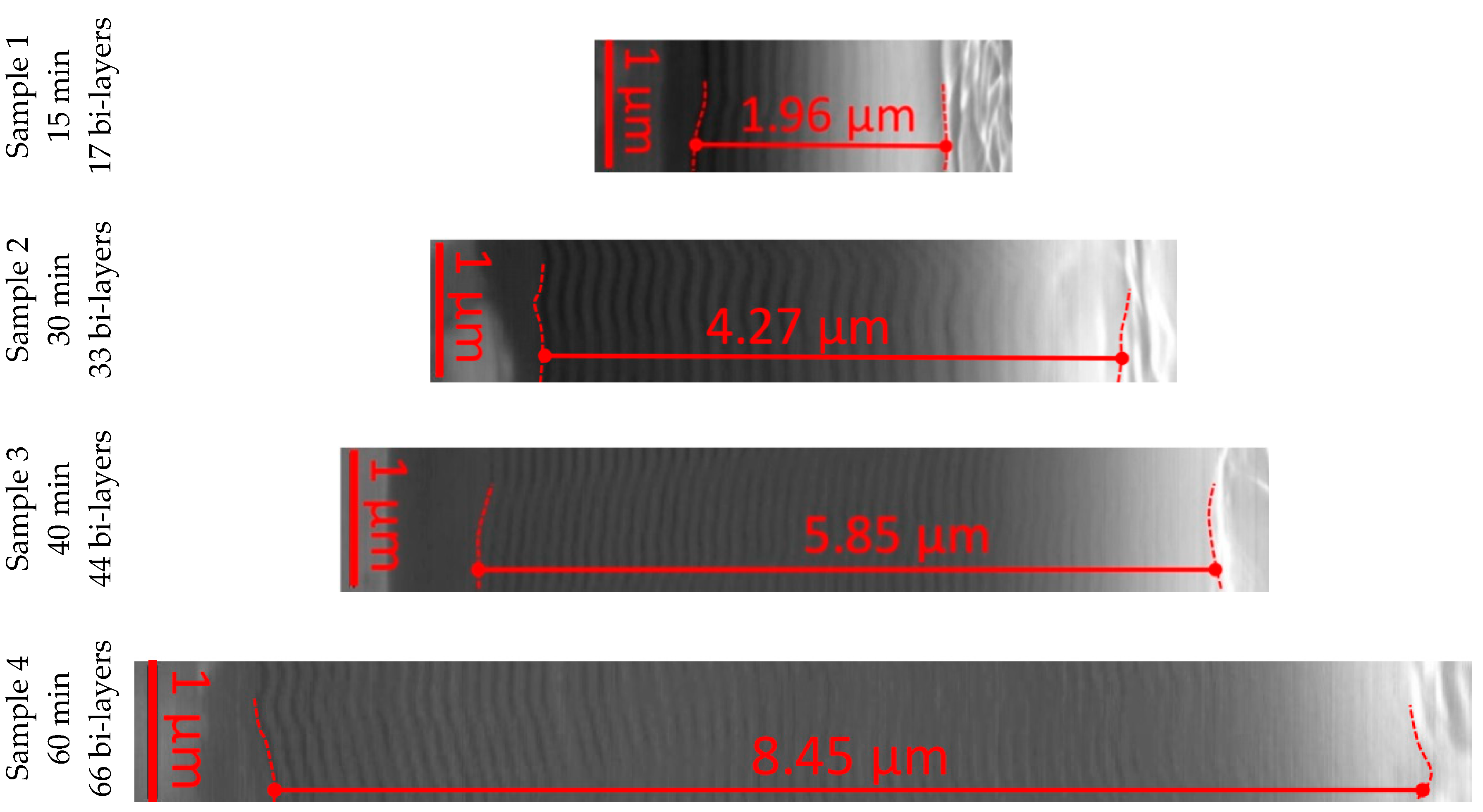
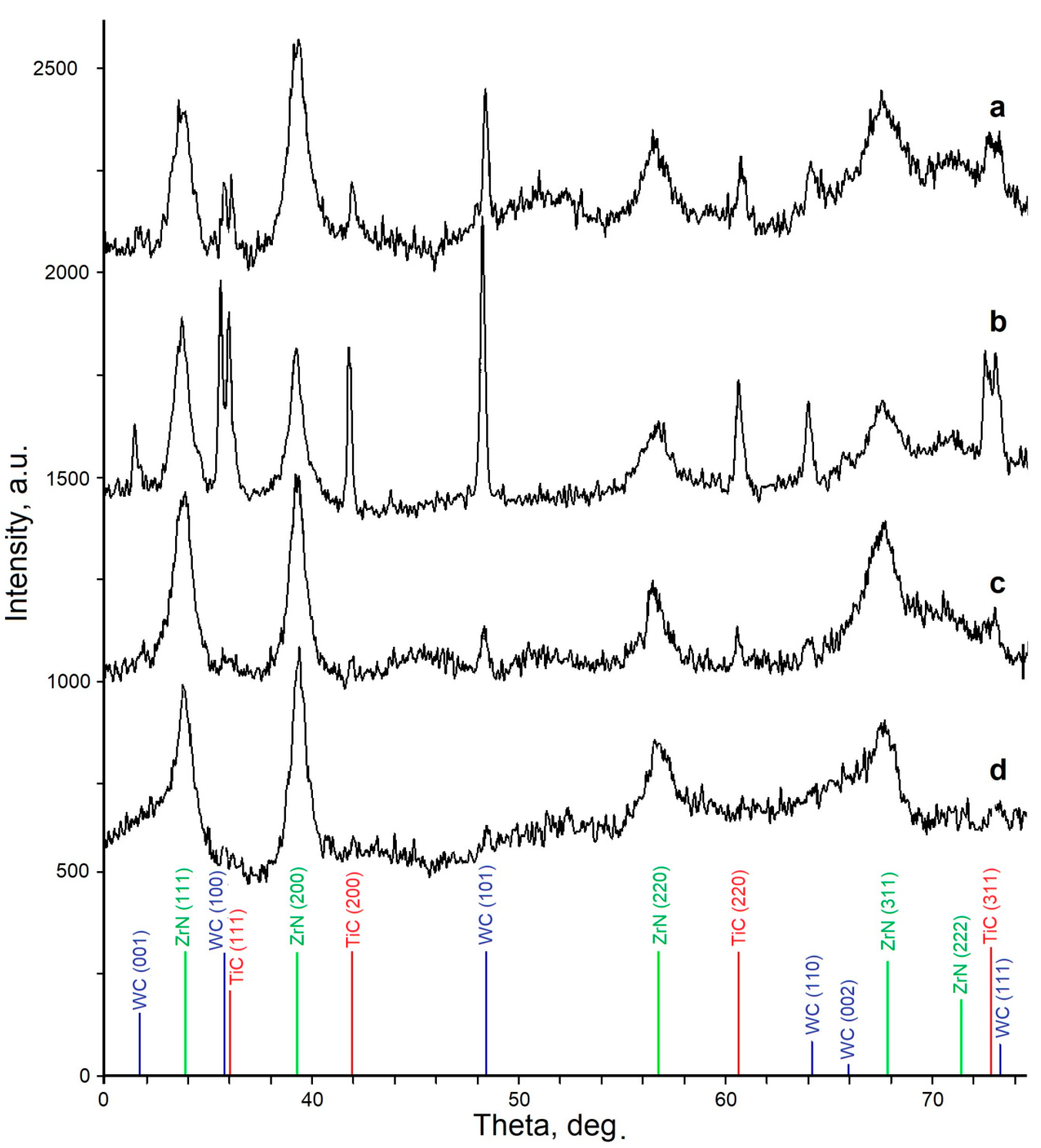
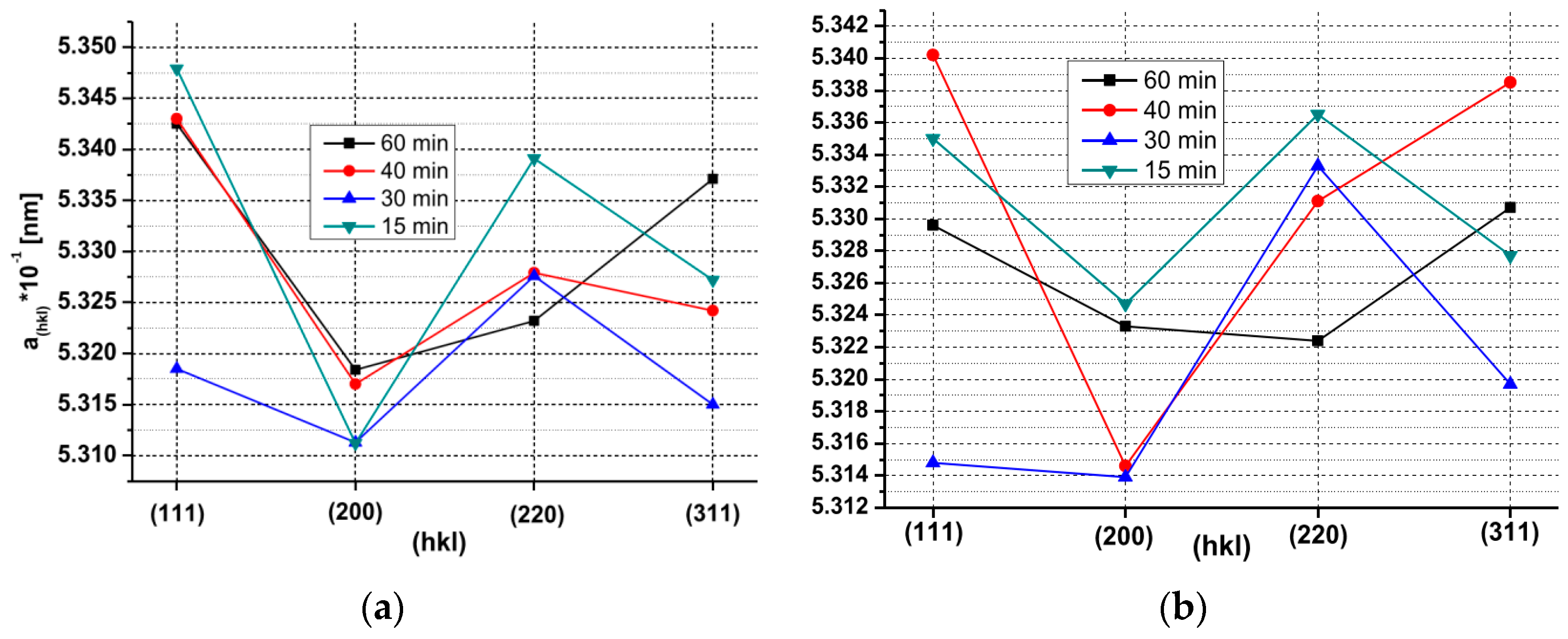
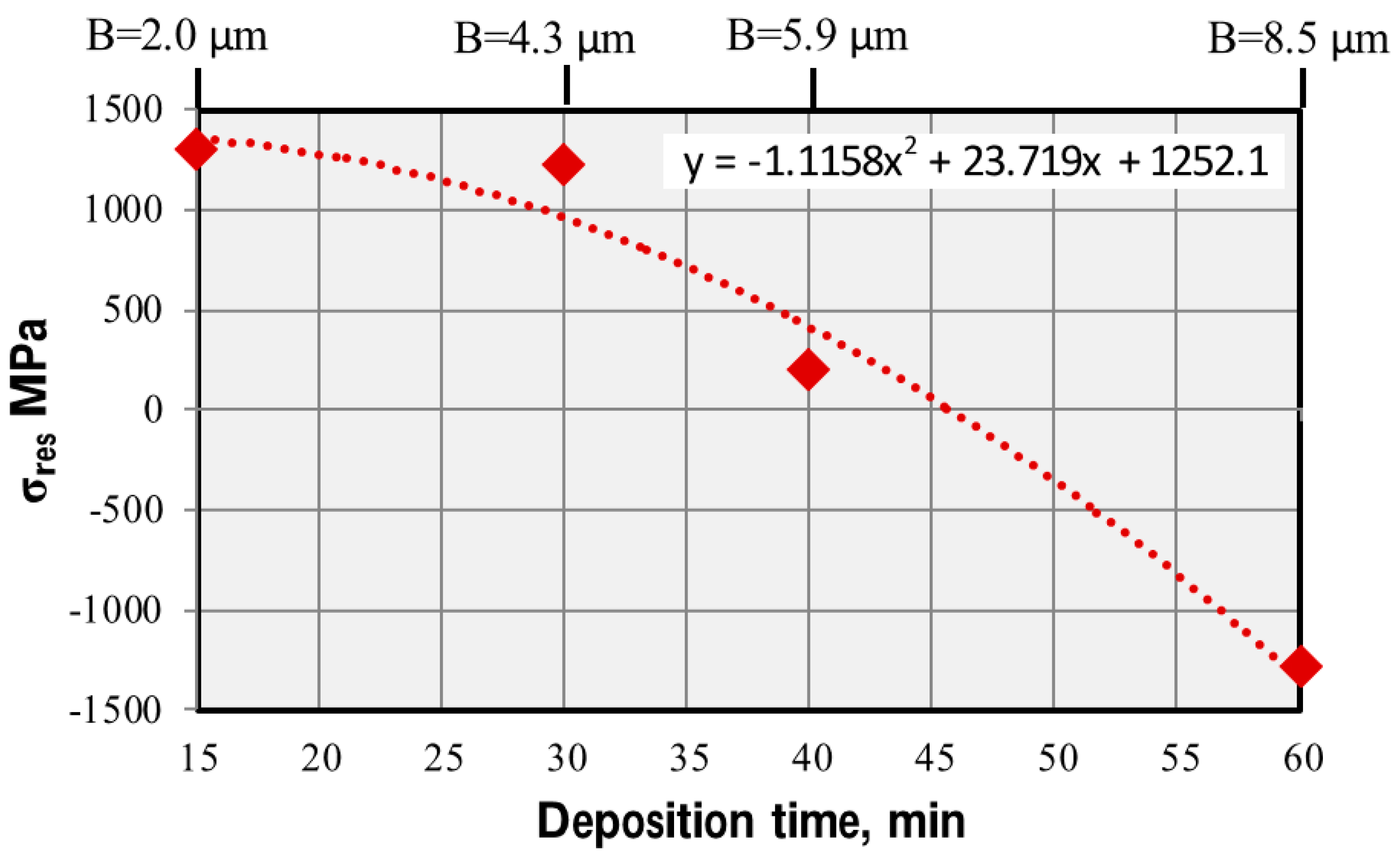
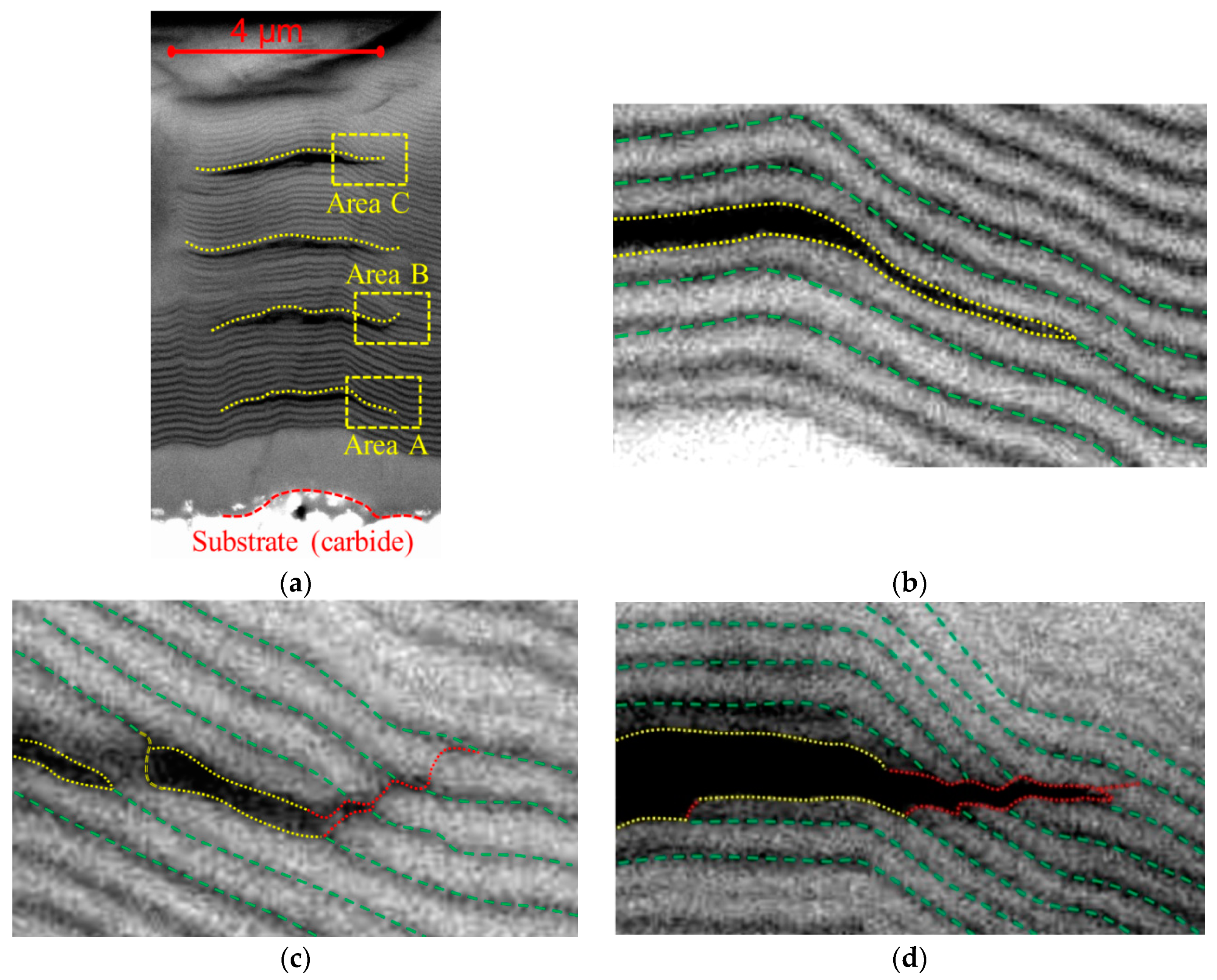
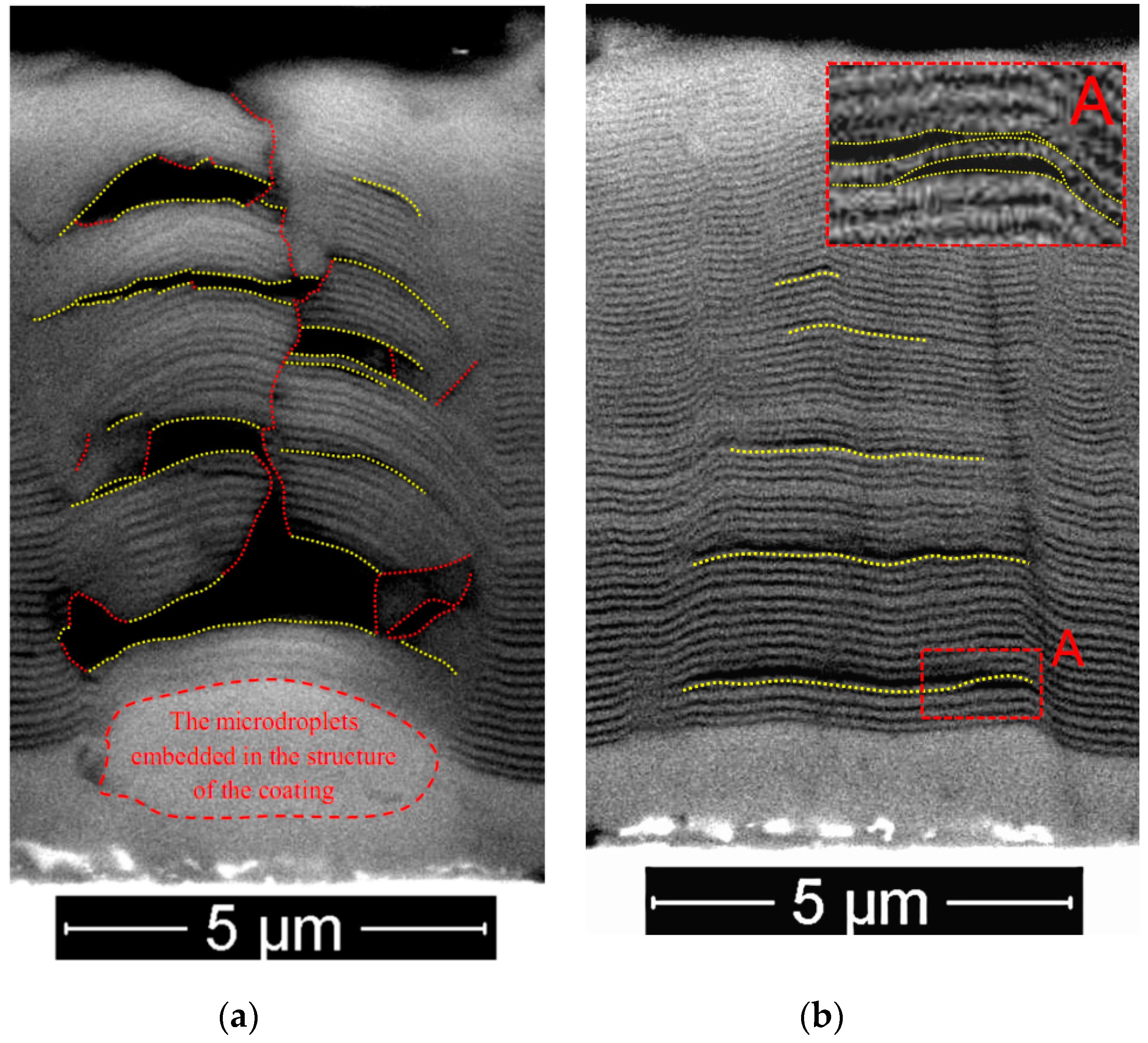
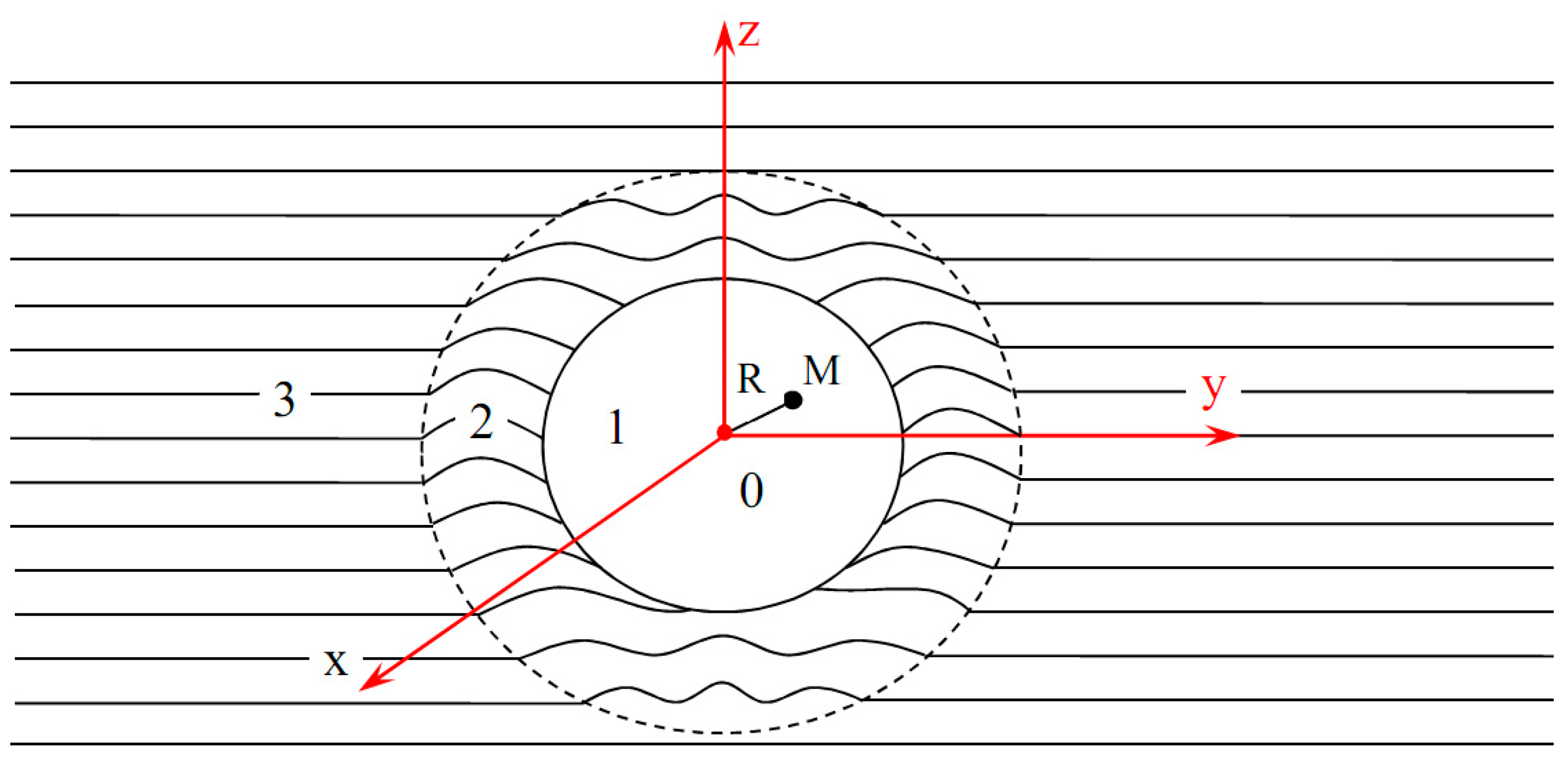
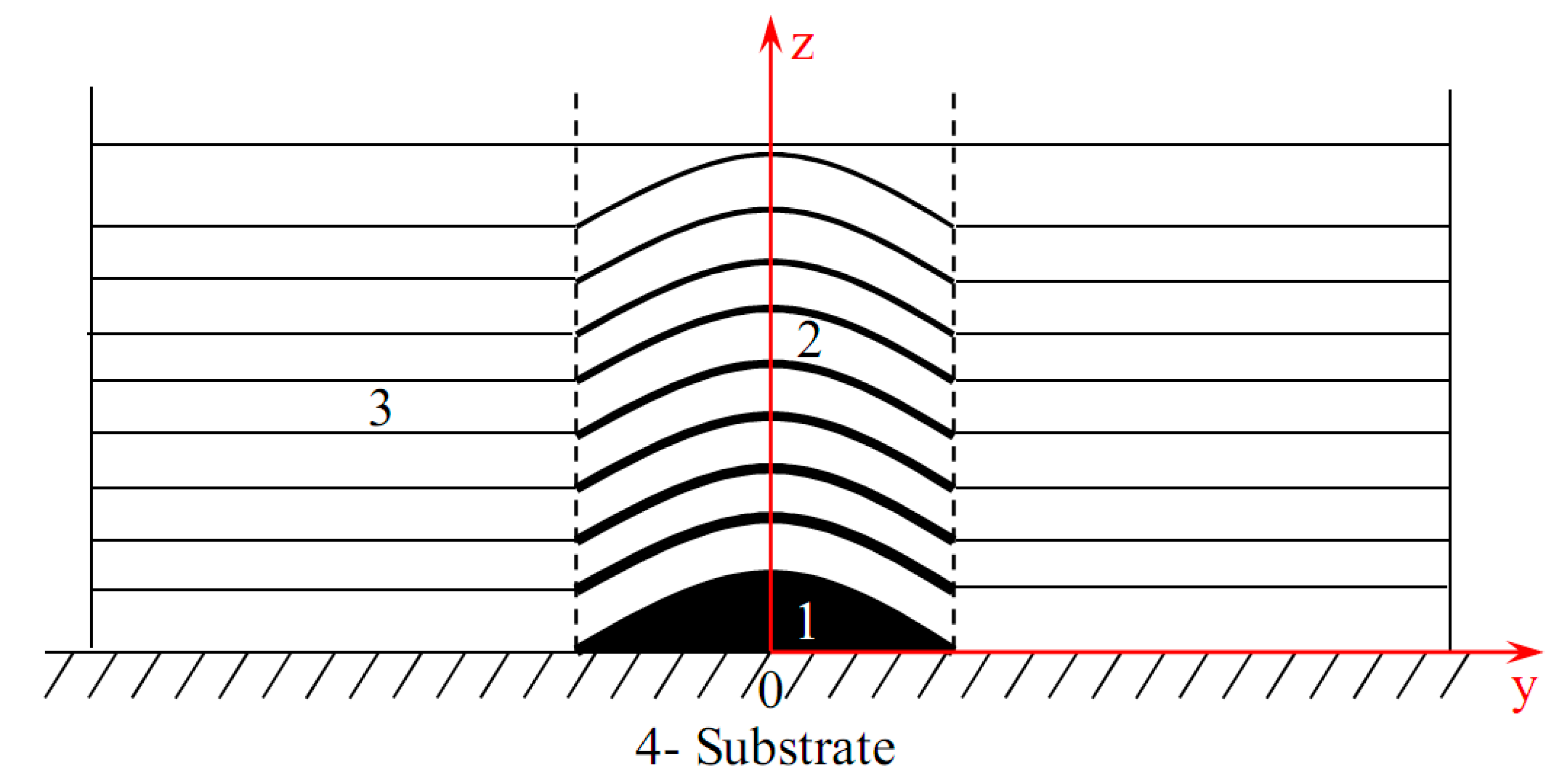
| Process | pN (Pa) | U (V) | IAl,Si (A) | IZr(A) | n (rev/min) |
|---|---|---|---|---|---|
| Pumping and heating of vacuum chamber | 0.06 | +20 | 120 | 75 | 1.1 |
| Heating and cleaning products with gaseous plasma | 2.0 | 100DC/900 AC f = 10 kHz, 2:1 | 80 | - | 1.1 |
| Deposition of coating | 0.36 | −800 DC | 160 | 65 | 1.1 |
| Cooling of products | 0.06 | - | - | - | - |
| Sample | 1 (15 min) | 2 (30 min) | 3 (40 min) | 4 (60 min) |
|---|---|---|---|---|
| Hardness, GPa | 28.7 | 29.1 | 29.3 | 28.5 |
| Sample 1 | ||||
|---|---|---|---|---|
| (hkl) | 2θ | σx (MPa) | σy (MPa) | |
| ax | ay | |||
| (111) | 33.704 | 33.788 | 1700 | 500 |
| (200) | 39.396 | 39.292 | 1700 | 700 |
| (220) | 56.613 | 56.643 | 2000 | 1500 |
| (311) | 67.735 | 67.728 | 1800 | 650 |
| Sample 2 | ||||
| (hkl) | 2θ | σx (MPa) | σy (MPa) | |
| ax | ay | |||
| (111) | 33.896 | 33.920 | 350 | 50 |
| (200) | 39.395 | 39.375 | 1000 | 1200 |
| (220) | 56.746 | 56.680 | 2100 | 2250 |
| (311) | 67.912 | 67.843 | 350 | 250 |
| Sample 3 | ||||
| (hkl) | 2θ | σx (MPa) | σy (MPa) | |
| ax | ay | |||
| (111) | 33.736 | 33.754 | 1200 | 1200 |
| (200) | 39.351 | 39.370 | 700 | 1300 |
| (220) | 56.743 | 56.705 | 600 | −1300 |
| (311) | 67.778 | 67.572 | 1650 | 100 |
| Sample 4 | ||||
| (hkl) | 2θ | σx (MPa) | σy (MPa) | |
| ax | ay | |||
| (111) | 33.739 | 33.823 | 100 | 300 |
| (200) | 39.340 | 39.303 | 300 | −50 |
| (220) | 56.797 | 56.807 | −2300 | −1400 |
| (311) | 67.592 | 67.685 | 500 | −100 |
| hkl | 200 | 220 | 311 | 222 | 400 | 331 | 420 |
|---|---|---|---|---|---|---|---|
| E (GPa) | 418.3 | 558.7 | 446.3 | 482.4 | 418.3 | 558.7 | 437.8 |
© 2020 by the authors. Licensee MDPI, Basel, Switzerland. This article is an open access article distributed under the terms and conditions of the Creative Commons Attribution (CC BY) license (http://creativecommons.org/licenses/by/4.0/).
Share and Cite
Vereschaka, A.; Volosova, M.; Chigarev, A.; Sitnikov, N.; Ashmarin, A.; Sotova, C.; Bublikov, J.; Lytkin, D. Influence of the Thickness of a Nanolayer Composite Coating on Values of Residual Stress and the Nature of Coating Wear. Coatings 2020, 10, 63. https://doi.org/10.3390/coatings10010063
Vereschaka A, Volosova M, Chigarev A, Sitnikov N, Ashmarin A, Sotova C, Bublikov J, Lytkin D. Influence of the Thickness of a Nanolayer Composite Coating on Values of Residual Stress and the Nature of Coating Wear. Coatings. 2020; 10(1):63. https://doi.org/10.3390/coatings10010063
Chicago/Turabian StyleVereschaka, Alexey, Marina Volosova, Anatoli Chigarev, Nikolay Sitnikov, Artem Ashmarin, Catherine Sotova, Jury Bublikov, and Dmitry Lytkin. 2020. "Influence of the Thickness of a Nanolayer Composite Coating on Values of Residual Stress and the Nature of Coating Wear" Coatings 10, no. 1: 63. https://doi.org/10.3390/coatings10010063
APA StyleVereschaka, A., Volosova, M., Chigarev, A., Sitnikov, N., Ashmarin, A., Sotova, C., Bublikov, J., & Lytkin, D. (2020). Influence of the Thickness of a Nanolayer Composite Coating on Values of Residual Stress and the Nature of Coating Wear. Coatings, 10(1), 63. https://doi.org/10.3390/coatings10010063







